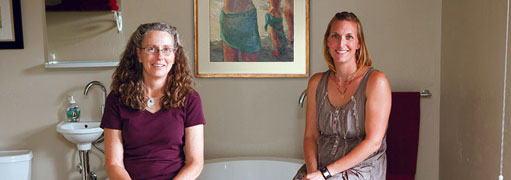Dar a Luz Birth & Health Center sits on a lush plot of land in the North Valley, set back from the road and abutted by agricultural plots. The sprawling center seems about as un-hospital-like as Abigail Lanin Eaves could make it. Dotted with skylights and large windows, it looks like a place people go to stay well, not get better. Even the front door is preceded by a bridge and pond. The theme of sanctuary is reflected throughout the center, with art by locals, a lending library, a kitchen and a classroom. There are two futon-stocked exam rooms, which Eaves likes to call “visiting rooms,” and two dedicated birthing suites that resemble rooms at a bed and breakfast.Eaves says she knew at age 12 that she was meant to deliver babies. She assumed it would be as an OB-GYN. When her sister had a home birth years later, Eaves was introduced to the world of midwifery, and there was no turning back.Eaves began midwifery school in 2000 at the University of New Mexico. As a student, she learned about birth centers run by certified nurse-midwives and was drawn to the idea. No such centers existed in the state when she graduated. “I always wanted a relationship with women,” she says. “I wanted them to have a relationship with someone they could trust.” Hospital obstetrics doesn’t provide that, she says, and so she decided to open a space that embraces her labor philosophy. That’s how Dar a Luz was born. The name directly translates as “to give light” in Spanish, but it can also mean “to give birth.”She got her start at Lovelace’s ABQ Health Partners, where she worked until 2009, catching more than 600 babies. “Catching” is the term midwives use, rather than “delivering.” “Catching babies is about shifting the focus to the mother,” Eaves says. “She birthed her baby. We were there to catch it.”Eaves had a baby of her own and took some time off. In May 2007, she officially incorporated and then, in August of that year, attained nonprofit status. She appealed the Legislature for funding, but the market crashed. “My big dreams were squashed,” she says. It took three more years to gather donations, take out a private loan and get some help from The Loan Fund.The nonprofit opened on March 24. It’s the only birth center in the state that’s run by certified nurse-midwives. The last of its kind, SouthWest Maternity Center, closed in 1985, Eaves says. She credits the 26-year gap to the difficulty involved in opening this kind of center.The staff at Dar a Luz is small. Melanie Yanke serves as the center’s full-time certified nurse-midwife, and Marie Meakin works part-time while finishing midwifery school. Yanke heard rumblings about the idea for the center in 2008 and contacted Eaves. “I kept on her,” she says. “I’d check in.” Yanke was instrumental in starting the center, working with Eaves to remodel the building. Evidence of Yanke is all over the place, with her clay and stone sculptures tucked into corners. Yanke also designed and landscaped the large backyard, which is surrounded by recycled cedar fence posts from her father’s ranch in Texas and contains a stone-lined walking labyrinth for mothers in labor.The labyrinth is symbolic of the Dar a Luz philosophy. The center focuses on natural childbirth, and it promotes a number of labor techniques that are difficult to find in a hospital. “We encourage women to keep moving,” says Eaves. “We don’t want you to stay in bed. The worst plan is staying in bed.” Walking through the labyrinth (which is easy to exit at any time) or using birthing balls keeps the body moving and “helps the baby to come into position,” Yanke says. “Gravity pushes the baby down.”Hydrotherapy is one of the methods Dar a Luz has available. “The water is relaxing,” says Eaves. When women get in a tub when they’re close to crowning, the water can help the baby come faster. Eventually, the center may also offer massage and acupuncture. Dar a Luz has had eight births so far, but there are about 20 more expected by December.Eaves says the birth center comes with a host of advantages. Prenatal exams “range from 30 to 60 minutes, as opposed to a five- to 15-minute visit in a hospital,” she says. That theme is echoed throughout a mother’s relationship with her midwife. During labor, mothers have at least two-on-one support, she says. “In a hospital, the chance of getting one-on-one support is very small.”Dar a Luz’ services are cheaper than a hospital’s. According to the New Mexico Hospital Association, 2010 costs for hospital care with uncomplicated deliveries rose to a baseline average of $6,645 statewide. Dar a Luz charges a flat $2,500. Discounts are also available for those who are un- or under-insured.Dar a Luz isn’t for everyone, though. For safety reasons, it only takes low-risk mothers. “There are very few situations where there becomes an emergent problem without signs leading up to it,” says Yanke. In case of an emergency, though, they will call 911. Eaves says nationally there’s only about a 10 percent transfer rate from birthing centers to hospitals during labor, and that most of those transfers aren’t prompted because of danger.The point of a birthing center is to ad intimacy to the birthing process, Eaves says. “Hospital delivery is just like a conveyor belt. I want more than that. It’s not just about catching babies.”
Dar a Luz Birth & Health Center
7708 Fourth Street NW
924-BABY (2229)





